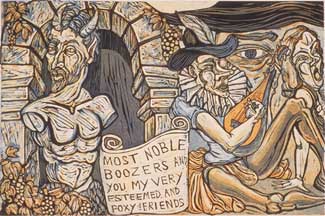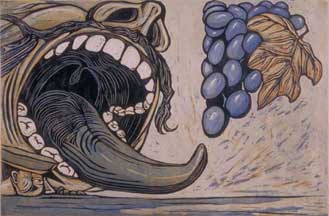|
Rabelais in the Vineyard
There is something about laughter that scares authority. Perhaps it is an element of violence, of a particularly potent and intimate form of violence, which erupts from within us. The uncontrolled blast of energy we call laughter fractures the surface of reality. It reminds us that our experience of the everyday world is governed by convention. We are only serious and obedient out of habit. And if our everyday world is mere habit, so is our acceptance of those who rule over us. For this reason, the great jokers of history have been seen as dangerous.
François Rabelais was a great joker. He was also the greatest writer of the French Renaissance-the French Shakespeare, if you will-and the source book for countless later writers and artists from Sterne to Balzac to Joyce, from Dorè to Derain. And nowhere is the proximity of laughter and violence explored with more intensity and breadth of vision than in Rabelais's "chronicles" of the adventures of the two giants Gargantua and Pantagruel, which Art Hazelwood has interpreted in the book you have before you. Beginning as a parody of medieval heroic literature, Rabelais's hilarious tales trace the wanderings of his gigantic characters through the cultural and political landscape of his day, from France to Utopia. Along the way, the author takes satirical aim at Church and King, teachers and lawyers, power-mad potentates and grasping merchants. Rabelais's mockery of thoughtless conformity has made his works the target of censors and philistines from the very moment of their publication (when they were condemned by the University of Paris) to the present day. Hazelwood's scenes set before us the dissonance between the pompous authority figures whom Rabelais lampoons and the out-sized heroes themselves, whose very bodies frequently become the stage where the tales are enacted. His images overlap and intertwine on several planes at once. They suggest both the zoom-like leaps of Rabelais's narrative, as it shifts location and context from episode to episode, and the sensual complexity of his energetic prose style.
But Rabelais is not only interested in satire. His writing cuts much deeper than mere wit, to explore the vanishing point where the destructive voice of satire leads to a vision of transformation, where laughter becomes violence and violence is undone by laughter. Rabelais haunts those places where words explode into excess or chaos, where images overflow their boundaries and change shape-permutations signaled here by the metamorphic energy of Hazelwood's forms, which seem to unfold, one from another.
It is beautifully appropriate that these images should come to us in book form. For, as one of the first European writers to exploit the technology of the printing press, Rabelais understood the power of the book and the danger contained in words and images. He also knew that the best art is art which can't be easily categorized or contained. Rabelais's books are like their exorbitant protagonists, oversized and exaggerated, filled with lists, puns, and jokes. They blend the learned and the popular, the epic and the trivial. Hazelwood's figurative style evokes Rabelais's linguistic exorbitance. And it bridges the historical gap between Rabelais and our own moment, suggesting certain features of Renaissance book illustration while rendering them completely contemporary.
Laughter is paradoxical. It harbors both violence and regeneration. And at the center of Rabelais's world-as of our own-is a profound sense of the crisis of community and of the need for a reinvention of our relationship to the social and political world. "Do what you will," advised Rabelais in Gargantua. But he is no libertine. For his giants embody social purpose and fight for the renewal of community and life. Writing in the 1530s and 40s, in the first flowering of the Renaissance in Northern Europe, Rabelais gives voice to emerging values that have shaped much of our own modernity--ideals of cultivated virtue, of heroism tempered by moral vision, of courage in the face of entrenched authority, of a fresh new sense of the power of humans to transform themselves and their world.
In Gargantua, the fragility of community is represented in the beautiful image of the vineyard and the motif of wine which runs throughout the work. Wine in Rabelais may be interpreted in any number of ways--as the nourishment of body and spirit (going back to the Song of Songs), as the elixir which binds community at any meal, as the sacramental blood of Christ which founds Christian Europe. The garden-like vineyard and the life force which it represents are constantly in danger in Rabelais's world. Still, they may be the only thing worth dying for. The confrontation between Rabelais's giants and the forces of reaction and dogmatism as they battle for the vineyard speaks directly to all moments in history-not least to our own, when cliché, doctrine, and false piety threaten the power of laughter and creation. Hazelwood's panorama renders, in stark fashion, the stakes of the Rabelaisian battle. The dynamism of the presentation-with its puffs of wind, bursts of laughter, and the pulse of appetite reaching for the succulent grape-directs us beyond battle, to the creative force that heals community.
On his deathbed, Rabelais is reported to have said, "I am going to seek a great maybe." Pious and exuberant, violent and hilarious, his writings offer--for our own fragile new century-a vision that is both dangerous and necessary.
Timothy Hampton
Berkeley, April 2002
|

